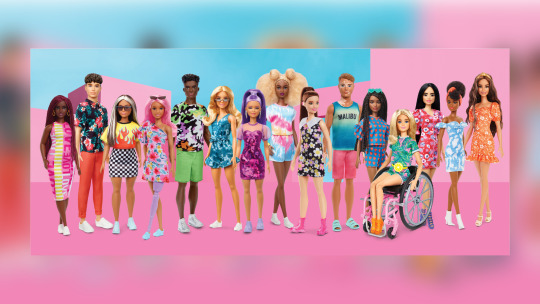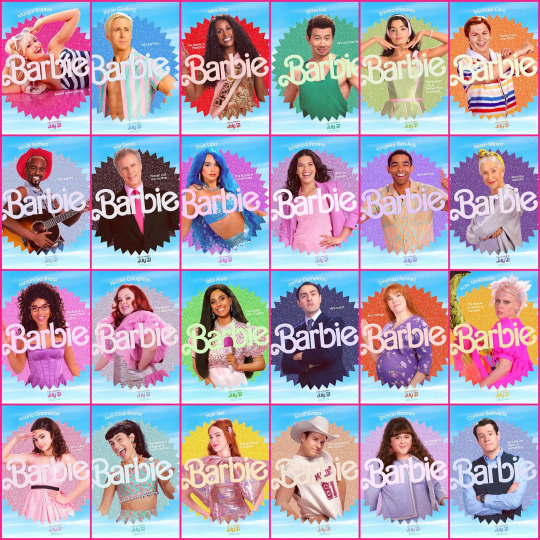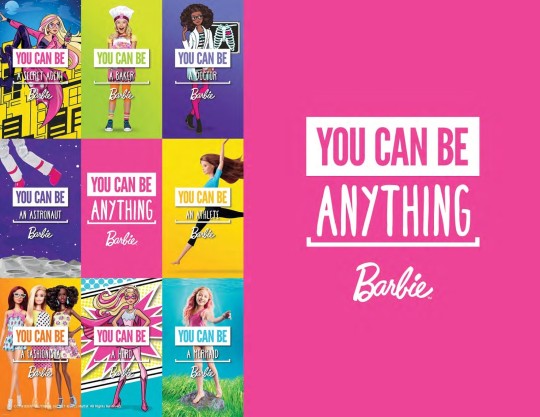Don't wanna be here? Send us removal request.
Text
“It is literally impossible to be a woman. You are so beautiful and so smart, and it kills me that you don't think you're good enough. Like, we have to always be extraordinary, but somehow we're always doing it wrong” - America Ferrera
0 notes
Text
Barbie's Impact on Generations of Women

“Hi there! I’m Barbie, and according to recent research, nearly 1 in 2 (45%) women compare the way they look to dolls like me” (Kuntz). Growing up, I always had a Barbie doll in my hand. I constantly begged my mom to take me to my local Walmart or Target to buy the newest doll. Throughout my childhood, I accumulated two huge pink boxes filled with Barbie dolls, their clothes, cars, and houses. I had female Barbies, male Barbies, teenage Barbies, child Barbies, baby Barbies, and even Barbies pets. Yet, even though my Barbies had wide age ranges, their body types did not. All my Barbie dolls had the same look to them, abnormally skinny with big chests. As stated by Psychiatric Times, Barbie’s body has made women across the world question their own body types and why it does not look like Barbie’s. Even though she is a doll, Barbie has caused a significant amount of damage in our society that has led to body insecurities from our face to our legs. Almost all of us know Barbie dolls and their famous slogan, “You can be anything.” However, it looks like the one thing we can not do is have a body type any different from Barbie's Infamous unrealistic one. I want to look into three aspects of how Barbie’s body was developed in the first place, how it affects women’s body image, and how Barbie’s body has changed over the years to be more inclusive. These will answer my overall question, How has the “stereotypical” Barbie doll set expectations for how women believe their bodies should look?

0 notes
Text
What Barbie Means to Me

"Ninety percent of American girls ages three to 10 own at least one Barbie" (Eaves). I cannot remember a time growing up when I did not have several Barbies scattered on my living room floor. When playing with the dolls, I felt like I was in a different world. A world where I truly believed I could be anything. In this world, I was a wife who had 4 children, a career in education, and lived in a lavish pink RV. When I was outside of my Barbie world, I would spend my days thinking about the next time I could play with my dolls. My favorite Barbies to play with was the child Barbies. They were so cute and small with different styles. I would scream out of excitement when my mom would bring one home from the store. Throughout my, childhood, Barbie dolls were my everything. I wanted to be just like my Barbies and look just like them. However, as I grew up, I slowly realized looking like their obscure body was not going to be possible.

0 notes
Text
How Was Barbie’s Body Developed in the First Place?

To answer our first question, “How was Barbie’s body developed in the first place?”, let’s do a deep dive ranging back to 1959. Barbie’s body is based on, “...a German doll called Lilli, a prostitute gag gift handed out at bachelor parties. Her proportions were designed accordingly” (Dockterman). Barbie was created by Ruth Handler and named after her daughter Barbra. It was put on store shelves in 1959. Even though Barbie was sexier than most dolls with a noticeably tiny body and big chest, Handler said in her New York Times obituary, “She didn’t see anything wrong with that” (Latson). Handler continued to say in her obituary that “Every little girl needed a doll through which to project herself into the dream of her future,”. (Latson) “If she (the little girl) was going to do role playing of what she would be like when she was 16 or 17, it was a little stupid to play with a doll that had a flat chest. So I gave it beautiful breasts” (Latson). However, as we know now and will look into later on, Barbie's dimensions are impossible to obtain and abnormal. From a young age, girls are aware of body sizes and how their own compares. They do not need any more influences on how their bodies should look, especially not from a fake doll. Studies show that even at the young age of three, girls are thinking about how their bodies look. Plus, playing with Barbie dolls has not made these thoughts any better. Psychology Today says, “A study published in 2006 found that 5-8-year-old girls who played with Barbies in an experiment desired thinner bodies than girls who did not” (Markey). By playing with Barbie, young girls’ impressionable minds are being told that their body needs to look like the dolls they are playing with. This creates an unhealthy body image that continues to grow with them as they grow older. Psychology Today's article, “Body Image and Barbie Mania”, continues to say that, “there is a classic study published in 1995 in The International Journal of Eating Disorders that determined the changes (in inches) required for a woman to approximate Barbie’s figure. Using hip measurements as a constant, a woman would need to be 24 inches taller, increase their neck by 3.2 inches in length, and increase their chest by 5 inches, all while decreasing their waist by 6 inches” (Markey). This study proves that it is impossible to make your body look like a Barbie doll. But with this being known, why do women still think their bodies should look like Barbie’s?

0 notes
Text
How Has Barbie’s Body Affected How Women See Their Own Bodies?

In society, a skinny body has always been admired and praised no matter how it is obtained. Once you have accomplished this “goal”, you feel like you have finally been accepted in the world. But, this feeling does not last too long as you can then become obsessed over how you need to be more skinny. However, my question is, “Has the look of Barbie dolls made women's desire to obtain this body increase?”. Studies report Barbie’s looks can affect females even after they stop playing with the dolls. Scientific American states, “...an interesting study found a significant correlation between younger exposure to playing with Barbie and a greater drive for thinness as a young adult” (Marris and Nature Magazines). National Library of Medicine also states that, “In fact, there are well-documented negative body image effects related to exposure to Barbie, including reduced body esteem and body satisfaction, higher body size discrepancy, thin-ideal internalization and desire for thinness, and restrictive eating behavior” (PLoS One). These ways of thinking can lead to girls developing eating disorders and depression at a young age. It especially did not help when Barbie released a book that said, “Don’t eat!”. In 1965, the Slumber Party Barbie came out with a Barbie-sized book on how to lose weight, which only stated the line to not eat. This doll also included a Barbie-sized pink scale that was stuck on the weight of 110 lbs. While this scale was removed from the store shelves after a year, the Barbie and book stayed, being renamed the Sleepytime Gal. This book is destructive to young minds, because it makes them think that if they want their body to look like Barbie’s they have to follow the one line said in the book. Thankfully, the doll has now gotten rid of the “weight loss” book and has more appropriate nighttime accessories like a stuffed bunny, a hairbrush, a cup of hot chocolate, etc. It is horrible that this was on the market for so long, perpetuating a destructive thought process for so many young girls and women. I am sure it further caused little girls' unhealthy body thoughts, but we will never fully understand or know the true impact it had. ProQuest stated, “Barbie's body proportions, as a cultural icon of female beauty, have received much criticism (e.g., Brownell, 1991), and empirical studies confirm that her body proportions are unrealistic, unattainable, and unhealthy” (Dittmar, Halliwell, and Ive). Fortunately, once females grow older, they are less likely to want Barbie’s dimensions because they realize it is unattainable and not a requirement to be “beautiful.” However, it is important to note that women are still more likely to develop eating disorders when they have already developed body image issues from a young age. Even though we will never actually know if Barbie dolls make women feel like they need to lose weight, we do know it definitely has contributed. We can see this in the TV shows, books, magazines, news stations, and everyday people in our lives that have caused us to feel insecure about our bodies, making us want to lose weight. Mattel is trying to stop these issues from their side by creating more diverse Barbies with a wide range of body types. Although, has this made anything better?

0 notes
Text
How Has Barbie’s Body Changed Over the Years to Be More Inclusive?

“Barbie’s got a new body” (Dockterman). In January of 2016, Barbie dolls got a brand new body. These bodies included curvy, tall, and petite to represent a wide variety of body types that are more realistic than the original Barbie body our society has grown accustomed to. However, has this diversity in body types actually made a difference in how women view their bodies? Does this change make females more confident with their body types? Unfortunately, it does not. The “Meanings of ‘thin’ and ‘fat’ are taught, so in a larger sense, it doesn’t matter what the dolls look like,” said Siewert, who cited a 2015 National survey that found about 90 percent of all women responding said they worried about their weight and had tried some kind of diet. “Living daily life as a woman, we’re so influenced by thin identity culture.” Body image issues have more to do with our treatment of others, than just with the dolls we play with at a young age. Body image issues are an epidemic in our world. At the end of the day, society has made people feel like they have to be as skinny as possible even before Barbie dolls were made. These issues have especially made it challenging for women whose looks seem to be held at a higher standard than men. As America Ferrera perfectly stated in her moving monologue in The Barbie Movie, “You have to be thin, but not too thin. And you can never say you want to be thin. You have to say you want to be healthy, but also you have to be thin…” (Gerwig). The Barbie Movie brought females together as we all truly thought about how challenging it is to be a woman. Females have always had such high standards put on them that are impossible to meet. When you make a doll with a “perfect” body, you are just emphasizing these harmful thoughts. Barbies were made to, “...inspire young girls that they can be anything they want to be and do not have to listen to the social norms. Ruth Handler wanted “to show her daughter she could aspire to a life and career that extended beyond taking care of babies” (McGarth and Forbes Team). We are finally getting to a place where we are also showing girls the true purpose of the meaning behind Barbie dolls. Barbie shows little girls that they can be whoever they want to be. They do not have to listen to the social norms that tell them they cannot be in male-dominated career fields but need to stay in their own realm of being a stay-at-home mom. And, we are doing this with Barbie that finally represents real female bodies. Mattel is now also making Barbie dolls with different skin tones, hair colors, styles, and now has one with Down syndrome. We are showing young girls it is natural to be different and not all the same. I hope that in the future, Barbie dolls get even more diverse.

0 notes
Text
“You can be anything”

“It is literally impossible to be a woman. You are so beautiful and so smart, and it kills me that you don't think you're good enough. Like, we have to always be extraordinary, but somehow we're always doing it wrong” (Gerwig). We all know Barbie dolls and their famous slogan, “You can be anything”. However, it looks like the one thing we can not do is have a body type any different from Barbie’s infamous unrealistic body. Growing up, I was always playing with my Barbie dolls. At my earliest of ages playing with them, I never thought twice about their body types. Yet, when I got older I realized no one could ever naturally look like the doll. However, we cannot completely blame Barbie dolls for this thought. We need to look back at our society. To answer our question, “How has the “stereotypical” Barbie doll set expectations for how women think their bodies should look?”, Barbie dolls have made girls at a young age further develop thoughts that they need to be skinny so they can look like Barbie because that is the doll they look up to. We live in a world where women are constantly being judged no matter what. Barbies should have never been made to be as skinny as they are. It is unrealistic and dehumanizing. We can all agree that it is very hard to be a woman in our world. We do not need people saying we need to look like Barbie. Women should be able to be anything they want to be and that also means women should also feel comfortable in their body and skin. No female should ever feel like they or their body is not good enough.

1 note
·
View note